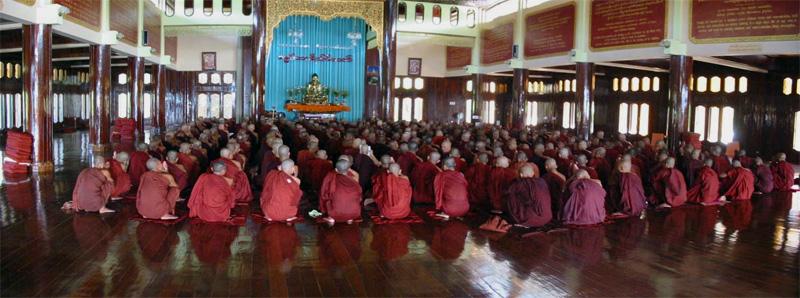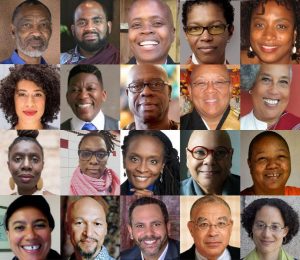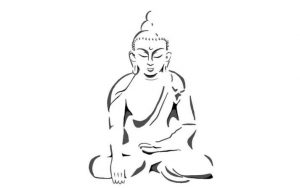
This article is the second in a series of three that explains more about the practice of rains-retreat (vassāvāsa), which is then followed by the Kathina ceremony.
The Buddhist monastic Saṅgha was not founded as the counterpart to the other sectarian traditions in the Buddha’s time, but rather it was an institution that evolved after gradual progress. The result of this progress, monastic rules and regulations were transmitted due to sociological environments and its internal principle of evolution. Members of the Buddhist Saṅgha were commonly recruited from all ranks of society. Because of the varied cultural dimensions in the growing Saṅgha population, a critical consequence of the differences generated a need for the communal life to be regulated within a framework of guidelines that everyone could adhere to.

The Buddhist idea of communal life, did not recommend living alone and companionless, but rather to settle in a congregation of monks. For that purpose, settlements quite naturally began and developed during the rains-retreat period. During rains-retreat, the societal and cultural differences of the population living together became an important matter to resolve in order to live peacefully together. As the number of monks and nuns gradually grew in numbers, they sought accommodation in the residence. Initially, misunderstandings and antagonism occurred between groups until everyone could find communion and harmony. For this reason and the sake of unity, the Buddha ordered the monastic Saṅgha to follow regulations, and also created the fortnightly celebration of the uposatha.
Uposatha is conducted on the eve of full moon and new moon days which marks special righteous days for the monastic members. Until today, it continues to be observed as the reciting of Pātimokkha, a record of rules governing the behavior of the Buddhist Saṅgha. The uposatha was enjoined for monastic Saṅgha to indicate more advanced practice in monastic life. The purpose of this celebration is a custom of the Buddhist Saṅgha who live in a permanent community and it allows them to engage in a form of communal activity among themselves. Another significance of the celebration of uposatha is the extensive bliss shared in development of monastic life. This is a communal activity and monastic members are not allowed to hold separate recitation of the Pātimokkhain their private compartments. They have to come together in a separate cell known as the observance hall, and the recitation is held in the presence of all monastic Saṅgha who live within the boundaries of the residence. This rule demonstrates the important spirit of cooperation within the community. These early rules and rituals of moral responsibility eventually evolved into the Vinaya Pitaka which governs the relationship of a monastic member within their community.

In order to recite the Pātimokkha and carry out other uposatha duties, the presence of a minimum of four monks is required. In the case when three monastics are present, there will be a different system. A senior monk will lead a discussion on individual purity based on one of the Vinaya codes. Each in turn will reflect and share on their purity of that particular issue. In a similar manner, if two monastics are present, based on their seniority, a purity review will ensue. For a single monk living alone in residence, on the uposatha day, he will personally reflect and make the determination within himself: today is my uposatha and practice awareness of the precepts with dedicated vigilance. According to tradition, Buddhist nuns also observe the uposatha but the distinguishing feature is that every half month they must enquire from the monks the precise date of the uposatha as part of their protocol.
The uniqueness of the uposatha is that it is not just limited to practice within a Buddhist monastic Saṅgha. Householders may also observe the day. In lay life, they may observe the uposatha on additional days to include: full moon day, new moon day, eighth day (two quarter moons of each month) and some other special days in the culture. On these days, they accept the eight precepts known as uposatha sīla in Pali, when they abstain from injuring life, theft, sex, lying, intoxicants, refrain from having solid food in improper time, refrain from dancing, singing, wearing garland, perfumes and refrain from lying on a luxuries sleeping place (eighth precept). By undertaking these precepts, lay followers also practice meditation; listen to Dhamma talks and so on. During the rains-retreat, the lay followers diligently observe each and every uposatha ceremony. In present day, Theravada Buddhists, mostly found in Thailand, Myanmar, Sri-Lanka, Bangladesh, observe the uposatha day with other ritual activities. One illustration of this type of other activity is shared below in personal experience:
Several years back, the usual procedure of uposatha was observed at a monastery in Kolkata, India by the monastic members and lay followers. In this instance, the starting date was an earlier one (purimikā in Pali) as the rains-retreat followed by Ᾱsāḷha full moon day. According to Buddhist history, the Buddha preached first sermon known as Dhammacakkhappavattana Sutta (setting the wheel of Dhamma in motion) on the Ᾱsāḷha full moon day. Many of the lay followers came to the temple on the special day dressed in white clothing and worshiped to the Buddha and Saṅgha monks as per normal tradition. Three Buddhist monks, including me,were presented and in front of us lay devotees were seated on mats spread on the floor.
At first they accepted the five precepts. However, many of the people adopted the eight precepts in part of the ceremony conducted by a senior monk who spoke in Pali. Everyone continued with a long period of chanting, paid homage to the Buddha, Dhamma and Saṅgha, and then made offerings of food, flowers, incense, lamps etc. All of us shared the accumulating merits to relatives, friends, family members and all sentient beings.The session concluded a short time before noon by the monks who drew attention to the devotees on the significant of the precepts. All devotees offered foods to the monks and those who adopted the eight precepts, ate their lunch in accordance with the timing of the monastic members. Later on, people who had attended the ceremony, had their lunch and offered to their relatives. After having lunch, there was a choice to stay in the monastery for an afternoon Dhamma talk, engage in discussion, read Dhamma books or practice meditation. Otherwise, one could go home as well.
In the evening, other people joined the group that undertook five precepts and engaged in evening chanting which concluded the uposatha ceremony. One variation worth mentioning, was that when I was a lay Buddhist in my village in Bangladesh, we kept the eight precepts until the next morning, thus continuing the uposatha until the next day. In the next morning all of us (who had adopted the eight precepts) returned to the monastery, gave up the eight precepts, and re-accepted the five precepts from the monastery monks. We did not have solid food in the afternoon (except for some juices) during the uposatha day as per normal Theravada tradition. Those who accepted the eight precepts were treated as holy men, and people who offered them juice and foods accumulated more merits when donating to this group.
During my time as a novice monk, when certain householders were physically challenged and unable to come to the temple, we went to their homes and honored their request to take the eight precepts. During the uposatha days, if a person is not closely affiliated with a local monastery, he or she can observe the uposatha day by undertaking the eight precepts in front of a Buddha image. According to this practice of privately taking precept vows, we can easily say that millions of people are practicing Buddhism around the world in a manner that is not necessarily visible in public.
Part 1 in this series: Buddhist Rains-retreat (vassavasa) – a courtesy of monasticism
Part 3 in this series: The Significance of the Kathina Robe Offering Ceremony











